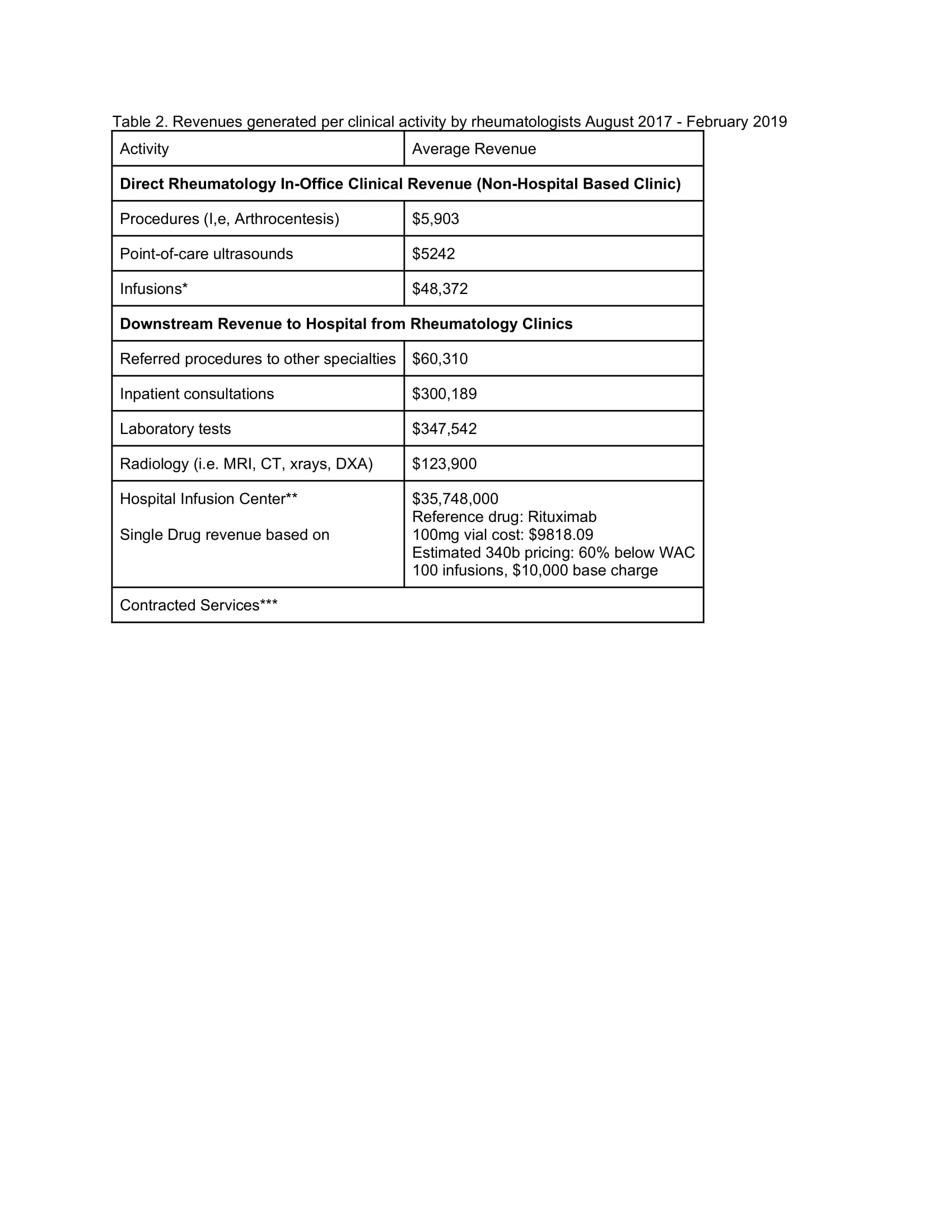Session Information
Session Type: Poster Session B
Session Time: 9:00AM-11:00AM
Background/Purpose: Finding a balance between clinical and scholarly productivity is a challenge for many academic clinician-educator (CE) rheumatologists. An examination of workload and practice-generated downstream revenue serves to determine if the financial value generated by services rendered by rheumatologists are proportionate to the financial value created for a health system. A 2005 study found that academic rheumatologists generate $10.02 for every $1.00 they receive for an office visit.[1] 15 years later, this study aims to determine the financial gains an academic health system can expect from CE rheumatologists.
Methods: A retrospective analysis of ordering practices from August 2017 – February 2019 was done.
Individual workload as averaged full-time equivalents (FTEs) based on time spent on inpatient consultation, outpatient faculty practice income-generating activities, academic and administrative duties. Revenue-generating activities were classified as those that benefited the hospital directly (downstream revenue) and the rheumatology division directly through the faculty practice (Table 1). CPT codes for all charges were assigned based on Medicare Allowable Charges for 2019.
One limitation encountered was the unavailability of hospital-based infusion center revenue. We extrapolated data based on infusion drug costs and reimbursement values of the most commonly prescribed drug prescribed (Rituximab 1000mg). We also reviewed academic productivity of faculty in the said period (Table 1).
Average FTE allocation is 0.2 FTE academic time, and 0.8 clinical duties with 0.4 FTE allocated for clinic care with trainees, and 0.4 FTE faculty practice clinic care. Faculty practice care was reduced for on-call hospital consultations (0.5 FTE). Additional FTEs allowances were given for clinical directorships (0.1 FTE), division chief (0.1 FTE) and fellowship program directorship (0.3 FTE). Academic productivity was notable (Table 1).
Results: An average of $229,041 between the five physicians for office visits was generated in evaluation and management services. The total downstream revenue generated from these visits averaged $36,579,941 per physician (Table 2). To calculate hospital infusion revenues, Rituximab 1000mg x 2 doses was used as a reference point dosed every six months (3 doses during the study time frame). 100 vials totaling 1,000mg at $9,818.09 per vial with 340b pricing considered gross revenue was $35,748,000 per physician.
Conclusion: For every $1 generated though office visits by the five practicing Academic Rheumatologists at our institution $159.70 dollars were generated through downstream revenue, nearly 16 times the 2005 study. Most likely this is an underestimation as this study is unable to account for eleven other infusion products. Consideration must be made to consider hospital-based support for by academic rheumatologists, and for additional compensation mechanisms that consider academic productivity.
[1] Wickersham, Pendleton, Diane Golz, and Sterling G. West. “Clinical academic rheumatology: getting more than you pay for.” Arthritis Care & Research: Official Journal of the American College of Rheumatology 53.2 (2005): 149-154.
 Legend: MRI, magnetic resonance imaging; CT, computed tomography, DXA, dual energy absorptiometry; US, ultrasound, WAC, wholesale acquisition price *In-office infusion revenues were based solely on procedure codes for infusions. We currently do not engage in drug buy & bill or other reimbursement programs. **Estimates of revenue as numbers of patients on various medications referred, 340b pricing and hospital charges for each drug, and each infusion procedure (J) code, for were not made available by administrators. Notes. Faculty also provide services at a county hospital, and 2 FQHCs. Average faculty salary $225,000 based on 80% private practice area salary and 20% academic salary
Legend: MRI, magnetic resonance imaging; CT, computed tomography, DXA, dual energy absorptiometry; US, ultrasound, WAC, wholesale acquisition price *In-office infusion revenues were based solely on procedure codes for infusions. We currently do not engage in drug buy & bill or other reimbursement programs. **Estimates of revenue as numbers of patients on various medications referred, 340b pricing and hospital charges for each drug, and each infusion procedure (J) code, for were not made available by administrators. Notes. Faculty also provide services at a county hospital, and 2 FQHCs. Average faculty salary $225,000 based on 80% private practice area salary and 20% academic salary
To cite this abstract in AMA style:
D'Anna K, Torralba K, Downey C, Silva Lynch C. Clinical Academic Rheumatology: A Boon for Health Systems [abstract]. Arthritis Rheumatol. 2020; 72 (suppl 10). https://acrabstracts.org/abstract/clinical-academic-rheumatology-a-boon-for-health-systems/. Accessed .« Back to ACR Convergence 2020
ACR Meeting Abstracts - https://acrabstracts.org/abstract/clinical-academic-rheumatology-a-boon-for-health-systems/

